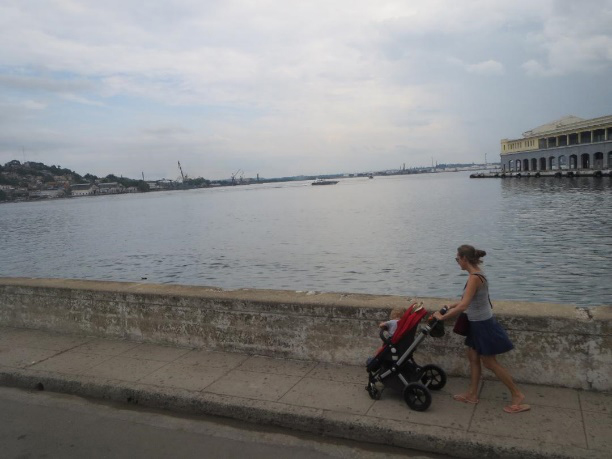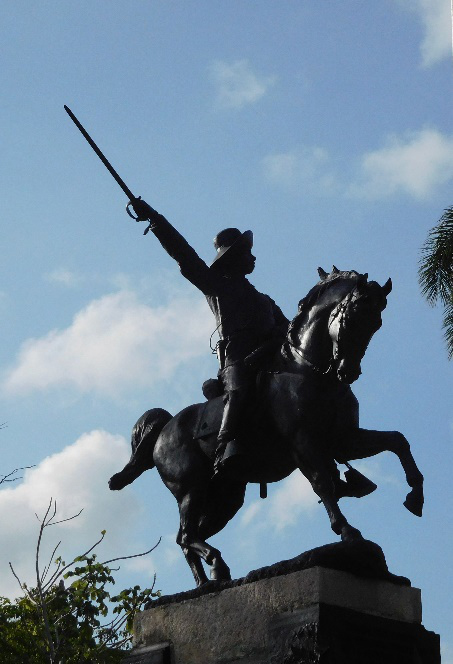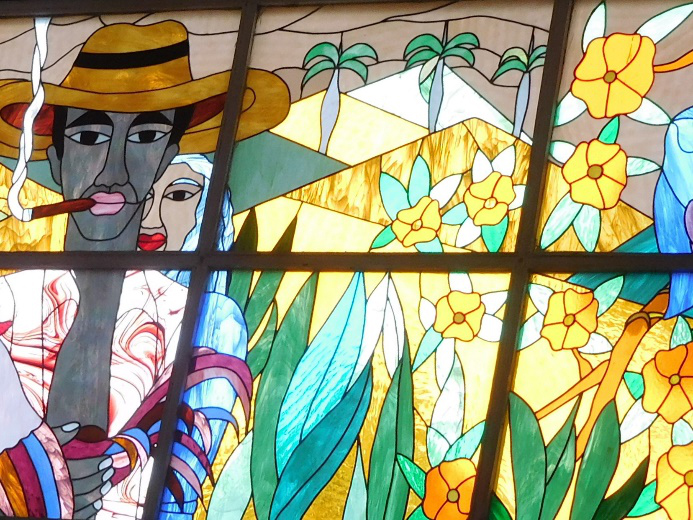A First Glimpse of Cuba
/(Photo by Gia Mendoza)
Before that, my earliest associations of Cuba were vague and flimsy, like the Arroz a la Cubana, which was part of my mother’s menu. I loved the cup-molded rice, accompanied by a fried egg, fried banana and ground meat with raisins.
Later, as I grew older and my worldview expanded beyond the simple meal whose origins were questionable, I looked forward to a trip to Cuba, although with some trepidation. The expectations were a half blank slate, a strange search for a country that had been dominated by the same colonial powers that influenced our history and our common values.
I was part of a group from my former organization, which organized reunions in some exotic places. This time it started with the Yucatan peninsula and Puebla in Mexico and ended with a trip to Cuba The slight uneasiness about travel to this place was based on recent warnings, and somewhat onerous requirements through newly crafted policies: The purpose should be clear that the trip’s objective must be educational, i.e., learning about people, and spreading the faith for an ideal democratic life; travel must be with a group, organized in America, but even then, the travel must be at your own risk. There were insidious attacks against western embassy personnel and tourists, in the form of undefined sonic attacks that resulted in hearing loss and other cognitive issues.
My friend Sonsoles, who lived in Cuba as representative of a UN agency there for a number of years, had assured us earlier it was safe and that what we should worry about should be dengue and hurricanes. So, off we went, armed with Off and mosquito repellants, rain jackets and umbrellas.
Havana
We flew from Mexico City and arrived in Havana on a Tuesday last October. We had to change to Cuban convertible pesos (CUC) at the airport to start our journey to this exotic land of Fidel Castro and Che Guevara. One got better exchange rates with euros rather than USD.
An old postcard of Manila by the Bay (Source: http://pinoykollektor.blogspot.com/2013/07/90-charm-of-old-manila-postcard.html
El Malecon, Cuba (Photo by Angioline Loredo)
Going through the Havana bay, there were a few people enjoying the esplanade near the bay, like it may have been in the ‘50s along what used to be Dewey Boulevard in Manila Bay.
Hotel Ambos Mundos where Hemingway used to hang out. (Photo by Gia Mendoza)
We were lodged at Hemingway’s former haunts, the Hotel Ambos Mundos. Decorated with mainly Hemingway memorabilia, it was glorious, but somewhat neglected, in terms of maintenance. Pictures of Hemingway, his typewriters, fishing rod and reel, adorned the dark walls, and his favorite room in the hotel was opened for viewing from 10 to 5 p.m.
The architecture of buildings in Havana was a combination of old Spanish, and tall Soviet buildings and new modern ones.
We saw the usual scene stops in Havana, including the cigar-making factory where no photos were allowed. Many Cubans smoked and the manager justified this, explaining that tobacco relieves stress (whereas life and work in the outside world caused more tension, lowered resistance and increased mortality rates).
We also visited a ballet school where many young dancers aimed to be the next Lizt Alfonso or Alicia Alonso, important to Cuban art and national pride, for a brighter future in and outside Cuba.
Little girls at a ballet school (Photo by Gia Mendoza)
We dined at different paladars, which were privately owned restaurants. Among them was La Floridita, which was Hemingway’s favorite. Typical Cuban food consisted of rice and black beans (called Moros y Cristianos), fish (often mahi-mahi), chicken with potatoes, pulled pork and beef (ropa vieja) and salad (grated cabbage, beets, carrots). And where there was food there was always Cuban rhythmic music, beckoning one to dance, even in place.
Festive Havana on the streets (Photo by Gia Mendoza)
More merrymakers in the streets (Photo by Gia Mendoza)
Many old American cars were out in the streets of Havana, beautifully kept, but often used as taxis, at 40 CUCs for an hour’s ride. A few of them claimed to have original motors.
Travel back in time (Photo by Gia Mendoza)
Colorful vintage cars in the streets of Havana (Photo by Gia Mendoza)
And one must not miss Jose Fuster’s Fusterlandia at Jaimanitas, just outside of Havana. Fuster’s art was a mix of Picasso, Gaudi and the artist’s own tastes, transforming his own neighborhood, with his own imprint.
The art of Jose Fuster (Photo by Gia Mendoza)
More at Fusterlandia (Photo by Gia Mendoza)
From Havana to Holguin and Santiago de Cuba
After four days in Havana we flew to Holguin, and then went by bus to Santiago de Cuba. We passed the shrine of Our Lady of Charity, the patroness of Cuba, located in El Cobre, where many faithful offer valuable possessions in exchange for favors.
The majority of Cubans claim to be Catholic, although of a syncretic version, since the colonizers had to blend strong indigenous beliefs, to spread the faith. No government official could subscribe openly to Catholicism, since complete fidelity to the political beliefs of Marxism and Leninism was opposed to religious tenets.
Santiago de Cuba is the second largest city, and the original Spanish capital
Fidel’s resting place (Photo courtesy of Angioline Loredo)
The Marti mausoleum (Photo courtesy of Angioline Loredo)
We toured the Ifigenia cemetery where revolutionary heroes are interred. It was particularly hot since Santiago was situated in a wind shadow, with the mountains of Sierra Maestra blocking the trade winds.
The grandest monuments were those of Jose Marti, the national hero, and Antonio Maceo, one of the greatest military heroes of the 1890s, immortalized in the form of 120 tons of bronze on a horse and 23 spears or machetes. Fidel’s specific request was not to build monuments in his name or develop a cult of personality around him.
The statue of Antonio Maceo (Photo by Gia Mendoza)
Only Che Guevara, who was born Argentinian but associated with the Cuban revolution, became a true icon, his face plastered all over Cuba in T-shirts, post cards, monuments.
Camaguey
Camaguey, is the third largest city, home to artists, heroes and sports stars, and distinctive for its medieval European influences in terms of urban layout of mazes and squares, and designated as a UNESCO world heritage site.
Ignacio Agramonte drafted the first Cuban constitution in 1869 (Photo by Gia Mendoza)
Cuban artists like Martha Jimenez live in Camaguey and her sculptures adorn the streets of the city, giving it an air of cultural respectability.
Jimenez's sculptures (Photo by Gia Mendoza)
Other than old American cars for hire, there were green options of taking horse-driven calesa rides, or tricycles (bici[cleat]taxis) for 10 CUCs an hour.
A green mode of transportation (Photo by Gia Mendoza)
Trinidad
(Photo by Gia Mendoza)
We looked forward to going to Trinidad, a town that used to be famous for sugar, but now thrives on tourism.
In Trinidad, we stayed at an all-inclusive resort hotel; unfortunately, the flies and mosquitoes fiercely took over at dusk and even daylight, and the place was a bit too crowded, even for Cuba.
Every meal had refreshing mojitos as starters for those who enjoyed them and made happy with white rum and garnished with limeade and mint leaves. In Trinidad, two competing signs in separate shops read, “The best mojito in Cuba,” and beside it, “The best mojito in the world.”
On our last night back in Havana, we went to a restaurant called “La Guarida” in a beat-up old building which opened up to a chic boho restaurant on the third floor. There we had the best tasting mojito, and then a special lechon de leche (roast piglet) called cochinillo with reduced orange marmalade sauce, from a fairly sophisticated menu.
There were two kinds of beer, Cristal, a light beer, and the stronger Bucanero, with 1% more of alcohol.
The last evening, we attended the Buena Vista Social Club with two remaining originals, but still wonderful sounding. After a few mojitos, many of us danced and drank and sang.
A few thoughts of Cuba then and now
Eddy, our guide, advised us at the outset: Do not compare what you see and experience here in Cuba with what you know elsewhere.
During our ten-day trip, we were given a lot of information, and justification on the rightness of the Cuba that is now, and in the end it was difficult to digest so much information on Cuban history and culture.
One cannot escape the revolutionary fervor and history that made Cuba, and its people “equal,” with universal access to basic health services. My friends who had stayed there long enough, say, however, that equality was a goal, but not a given.
In the street landscape, inevitably there were the few who tried to gain more benefits than others. There were beggars, or touts (jineteros), including women, who offer whatever services a tourist might want, or children who asked for candy (or money). Tips are always encouraged, if not expected, by musicians and toilet maintenance ladies.
Although there were no bony, starving kids, obesity was creeping in, according to UNICEF data, due possibly to poor nutrition education.
Portrait of a child (artist unknown)
I had read earlier that there were Filipinos who jumped off galleon trade ships on their way to or from Mexico in the 16th century, and got to Pinar del Rio (once called “Nueva Filipinas”), which, unfortunately, we did not get to investigate further.
We did agree in general that we were safe when we were there, and we had a trip-worthy, educational and enjoyable experience.
It is said that in 2019 Raul Castro will permit a general election for leadership of Cuba, which will not include him for a third term.
I leave Cuba, and for a while, I can still hear the old songs “Guantanamera” and “Que Rico Vacilon” playing in my head.
Gia, Eddy the tour guide, Noni, my brother, and Michael Reeves
Gia R. Mendoza worked as an international civil servant for many years, and is now retired in Washington State. She enjoys writing and painting.
More articles from Gia Mendoza





















